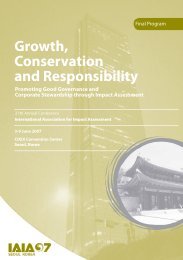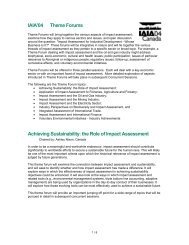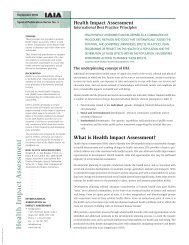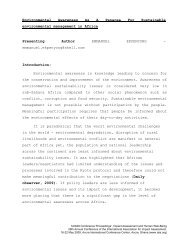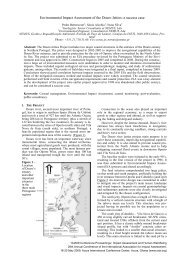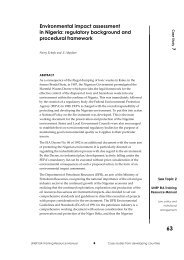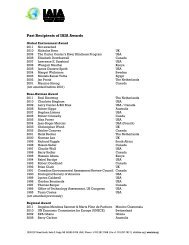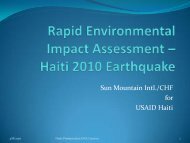Power, poverty and sustainability - International Association for ...
Power, poverty and sustainability - International Association for ...
Power, poverty and sustainability - International Association for ...
Create successful ePaper yourself
Turn your PDF publications into a flip-book with our unique Google optimized e-Paper software.
• IAIA06 Abstracts Volume •<br />
Integration of Environmental Management System<br />
<strong>and</strong> EIA in the Swedish National Rail Administration<br />
Lundberg, Kristina; Royal Institute of Technology (KTH),<br />
Brinellvägen 28, Stockholm, SE-100 44 Sweden. +46 8 790<br />
6141. krilun@kth.se<br />
Bal<strong>for</strong>s, Berit; Royal Institute of Technology (KTH),<br />
Brinellvägen 28, Stockholm, SE-100 44 Sweden. +46 8 790<br />
6352. bal<strong>for</strong>s@kth.se<br />
Folkeson, Lennart; Royal Institute of Technology (KTH),<br />
Brinellvägen 28, Stockholm, SE-100 44 Sweden. +46 8 790<br />
7376. lennart.folkeson@vti.se<br />
The two management tools Environmental Impact Assessment<br />
(EIA) <strong>and</strong> Environmental Management System (EMS) are<br />
often used in isolation. This is the case also at the Swedish<br />
National Rail Administration. Environmental in<strong>for</strong>mation <strong>and</strong><br />
decisions expressed in the EIA during the planning of a project<br />
are seldom transferred to the construction phase <strong>and</strong> further<br />
to the operational phase <strong>and</strong> the EMS. Any continuous<br />
environmental monitoring is usually not based on the findings<br />
in the EIA. The lack of integration of the management tools<br />
<strong>and</strong> the poor transfer of in<strong>for</strong>mation have had a negative<br />
effect on the follow-up of the environmental outcome of rail<br />
projects.<br />
A research study has been initiated with the aim to improve<br />
the environmental monitoring within the Rail Administration<br />
by exploring ways of combining EIA <strong>and</strong> EMS. Three rail<br />
projects are being examined from the planning stage through<br />
construction to operation. The focal stage is the h<strong>and</strong>ing over<br />
of the project to the administration <strong>for</strong> continual operation.<br />
Based on findings from the case studies, a model will be<br />
developed <strong>for</strong> the integration of EIA <strong>and</strong> EMS. The model will<br />
facilitate the integration of EIA decisions with the operational<br />
EMS, which will improve the environmental outcome of rail<br />
projects.<br />
Environmental Administration System as a Tool to<br />
Improve the Environment Impact Assessment<br />
Guido-Sequeira, Harman; ICE, CSRG - Campo Geotérmico<br />
Miravalles, guayabo de Bagaces Guanacaste, Guanacaste,<br />
Costa Rica. (506) 673 0100. Fax 673 0132. hguido@ice.go.cr<br />
The conservation of the environment cannot be sought by<br />
sacrificing the development <strong>and</strong> well-being of a nation, since<br />
the conservation alone doesn’t contribute to reduce <strong>poverty</strong>.<br />
For this reason the concept of sustainable development looks<br />
<strong>for</strong> a balance between development <strong>and</strong> environmental<br />
conservation, <strong>and</strong> the EMS can be used to get this balance.<br />
But why should the organization have to implement an<br />
environmental management system? The main idea of the<br />
EMS is to prevent all kind of contamination, try to reduce the<br />
contamination, <strong>and</strong> if any of these solutions are possible, then<br />
it will focus on to mitigate the contamination. The<br />
organization can reduce the costs if it teaches the people<br />
about the importance of reduce the unnecessary use of<br />
material, electricity, water, paper, etc. It will represent a high<br />
efficiency <strong>and</strong> less production costs. Also, it has to be taken<br />
into account that the communities have a lot of power. If they<br />
are against the project it will mean problems that can be<br />
prevented <strong>and</strong> solved by a correct EMS. The EMS can also be<br />
used as a tool to ensure the appropriate implementation of the<br />
environmental programs established in the EIA <strong>and</strong> improve<br />
the EIA itself.<br />
Environmental Managment <strong>and</strong> Environmental<br />
Management Tools in Practice: The View of the<br />
Environmental Managers<br />
Nitz, Tracey; University of East Anglia, School of<br />
Environmental Sciences, University of East Anglia, Norwich,<br />
Norfolk NR4 7TJ United Kingdom. 44 1603 593130.<br />
t.nitz@uea.ac.uk www.uea.ac.uk/env<br />
Brown, Lex; Griffith University, Faculty of<br />
Environmental Science, Griffith University, Nathan,<br />
Queensl<strong>and</strong> 4111 Australia. lex.brown@griffith.edu.au<br />
A plethora of environmental management tools have<br />
emerged over the last 40 years, such as EIA, SEA, EMS,<br />
life cycle assessment <strong>and</strong> corporate environmental<br />
reporting. These tools are the subject of much discussion<br />
<strong>and</strong> debate in the environmental management literature.<br />
In particular, the benefits of using environmental<br />
management tools <strong>and</strong> the drivers <strong>for</strong> using them have<br />
been discussed at length. There is, however, limited<br />
knowledge about the actual use of the various tools in<br />
practice.<br />
This paper presents the results of an empirical study of<br />
environmental management practices of 23 large<br />
organisations in Australia, based on in-depth interviews<br />
with environmental managers. It describes the<br />
environmental management tools used by these<br />
organisations <strong>and</strong> the activities of environmental<br />
managers within them. The views of environmental<br />
managers about various environmental management<br />
tools are presented. The main factors that influenced the<br />
decisions of environmental managers are discussed. The<br />
key issues <strong>for</strong> environmental managers were making the<br />
business case <strong>for</strong> the use of environmental management<br />
tools <strong>and</strong> the ease with which a tool can be adapted <strong>for</strong><br />
their organisation. On the basis of these findings, a<br />
number of recommendations <strong>for</strong> improving the use <strong>and</strong><br />
effectiveness of environmental management tools in<br />
practice are made.<br />
Links Between Environmental Impact<br />
Assessment <strong>and</strong> Environmental Management<br />
Systems – A Conceptual Framework<br />
Krijnen, Justin; Institute of Environmental Management<br />
<strong>and</strong> Assessment (IEMA), St Nicholas House, 70<br />
Newport, Lincoln, Lincolnshire LN1 3HQ United<br />
Kingdom. 01522540069. j.krijnen@iema.net<br />
Environmental Impact Assessment (EIA) <strong>and</strong><br />
Environmental Management Systems (EMS) are<br />
perceived by many to be separate environmental tools.<br />
Essentially this is true. EIA serves as a systematic <strong>and</strong><br />
predictive tool <strong>for</strong> assessing the potentially significant<br />
impacts of developments on the environment. An EMS,<br />
on the other h<strong>and</strong>, is used to consider the key impacts of<br />
operational businesses on the environment. The main<br />
difference to note is that during the EIA process impacts<br />
on developments are predicted. A proposed development<br />
has yet to be built <strong>and</strong> there<strong>for</strong>e an element of<br />
uncertainty is associated with these assessments. With<br />
an EMS, the business or organisation’s processes are<br />
already in operation. Even though there is also an<br />
element of prediction involved, it is a comparatively<br />
easier task to investigate what the environmental<br />
impacts of these processes are. Yet, however separate<br />
these assessment tools may appear to be, it is possible to<br />
integrate elements of each tool to aid in the process of<br />
managing the environmental impacts of developments<br />
<strong>and</strong>/or businesses. This e-briefing identifies the links<br />
between EIA <strong>and</strong> EMS <strong>and</strong> how a combination of both<br />
instruments may help to improve impact prediction <strong>and</strong><br />
management.<br />
52


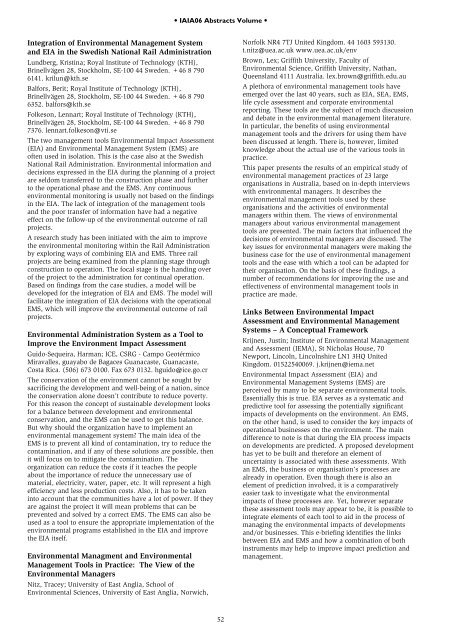

![Session Report [PDF] - International Association for Impact Assessment](https://img.yumpu.com/22416146/1/190x245/session-report-pdf-international-association-for-impact-assessment.jpg?quality=85)
![Session Report [PDF] - International Association for Impact Assessment](https://img.yumpu.com/22416140/1/184x260/session-report-pdf-international-association-for-impact-assessment.jpg?quality=85)
